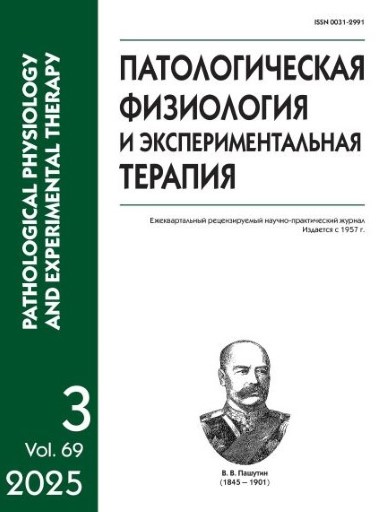Cysteine, homocysteine and their redox status as a predictor of death in patients on hemodialysis
Abstract
Introduction. Chronic kidney disease (CKD), especially its end stage, that requires renal replacement therapy, is characterized by high cardiovascular morbidity and mortality. Uremic syndrome associated with CKD facilitates oxidative stress, endothelial dysfunction, and inflammation and, thereby, plays a key role in the development of cardiovascular complications. Cysteine and homocysteine form a thiol-disulfide system in a state of dynamic equilibrium. The imbalance between reduced and oxidized forms of these aminothiols may reflect the degree of oxidative stress and its contribution to the development of CKD complications. The aim of this study was to identify the prognostic role of cysteine, homocysteine and their redox status in blood plasma of patients with terminal renal insufficiency.
Methods. The study included 47 patients who received renal replacement therapy (hemodialysis) for at least 3 months prior to blood sampling. The follow-up period was 3 years.
Results. It was found that a high level of total content of cysteine and homocysteine, a low level of their reduced forms, and a low redox status of cysteine (<1%) and homocysteine (<6%) are independent predictors of death in hemodialysis patients (odds ratio 4.7 and 4.8, respectively, p< 0.05). An increase in the plasma pool of homocysteine due to its insufficient utilization by the kidneys leads to an increase in its cellular concentration and activation of trans-sulfurization enzymes that convert homocysteine into cysteine. This contributes to an elevation of plasma cysteine. Disorders of homocysteine metabolism are not only evident as increased total cysteine content but also affect the thiol-disulfide balance of aminothiols.
Conclusion. The total content, reduced forms, and redox status of cysteine and homocysteine are independent predictors of death in hemodialysis patients. Assessment of the redox status can be useful for risk stratification and the development of personalized therapeutic strategies for restricting oxidative stress and improving prognosis in this category of patients. Further studies are needed to evaluate the effectiveness of antioxidant therapy and other interventions aimed at the correction of the redox balance in hemodialysis patients.
Downloads
References
2. Braun MM, Khayat M. Kidney Disease: Chronic Kidney Disease. FP Essent. 2021 Oct;509:20-25. PMID: 34643361.
3. Pavão ML, Ferin R, Lima A, et all. Cysteine and related aminothiols in cardiovascular disease, obesity and insulin resistance. Adv Clin Chem. 2022;109:75-127. doi: 10.1016/bs.acc.2022.03.003. Epub 2022 Apr 29. PMID: 35953129.
4. Garavaglia ML, Giustarini D, Colombo G, et. all. Blood Thiol Redox State in Chronic Kidney Disease. Int J Mol Sci. 2022 Mar 5;23(5):2853. doi: 10.3390/ijms23052853. PMID: 35269995; PMCID: PMC8911004.
5. Yamauchi K, Kawakami Y. The redox status of cysteine thiol residues of apolipoprotein E impacts on its lipid interactions. Biol Chem. 2020 Apr 28;401(5):617-627. doi: 10.1515/hsz-2019-0414. PMID: 31913846.
6. Xiao W, Ye P, Wang F, et all. Plasma Homocysteine Is a Predictive Factor for Accelerated Renal Function Decline and Chronic Kidney Disease in a Community-Dwelling Population. Kidney Blood Press Res. 2021;46(5):541-549. doi: 10.1159/000514360. Epub 2021 Aug 6. PMID: 34365457.
7. Chen W, Feng J, Ji P, et all. Association of hyperhomocysteinemia and chronic kidney disease in the general population: a systematic review and meta-analysis. BMC Nephrol. 2023 Aug 23;24(1):247. doi: 10.1186/s12882-023-03295-y. PMID: 37612681; PMCID: PMC10463317.
8. Kruglova MP, Ivanov AV, Fedoseev AN, et all. The Diagnostic and Prognostic Roles Played by Homocysteine and Other Aminothiols in Patients with Chronic Kidney Disease. J Clin Med. 2023 Aug 30;12(17):5653. doi: 10.3390/jcm12175653. PMID: 37685718; PMCID: PMC10488590.
9. Дзугкоев, С. Г. Дзугкоева Ф. С., Гадиева В. А. Показатели общих и восстановленных форм аминотиолов в плазме крови как биохимических маркеров эффективности гемодиализной терапии у пациентов с терминальной хронической почечной недостаточностью. Бюллетень экспериментальной биологии и медицины. 2024.Т. 178, 9. 301-305. – DOI 10.47056/0365-9615-2024-178-9-301-305. – EDN SGODUS.
10. Rookyard AW, Paulech J, Thyssen S, et all. A Global Profile of Reversible and Irreversible Cysteine Redox Post-Translational Modifications During Myocardial Ischemia/Reperfusion Injury and Antioxidant Intervention. Antioxid Redox Signal. 2021 Jan 1;34(1):11-31. doi: 10.1089/ars.2019.7765. Epub 2020 Sep 25. PMID: 32729339.
11. Ivanov AV, Alexandrin VV, Paltsyn AA, et all. Prevent the Decline of the Redox Status of Low-Molecular-Weight Aminothiols in Blood Plasma of Rats During Acute Cerebral Ischemia. J Cardiovasc Pharmacol. 2018 Oct;72(4):195-203. doi: 10.1097/FJC.0000000000000616.
12. Круглова М. П., Иванов А. В., Введенская О. Ю., Кубатиев А. А. Гипергомоцистеинемия и хроническая болезнь почек // Патологическая физиология и экспериментальная терапия. 2018. Т. 62. № 4. С. 195–201
13. Williams RH, Maggiore JA, Reynolds RD, Helgason CM. Novel approach for the determination of the redox status of homocysteine and other aminothiols in plasma from healthy subjects and patients with ischemic stroke. Clin Chem. 2001 Jun;47(6):1031-9. PMID: 11375288
14. Glushchenko A.V., Jacobsen D.W. Molecular targeting of proteins by L-homocysteine: mechanistic implications for vascular disease. // Antioxid. Redox Signal.- 2007 - v. 9(11) – p. 1883-1898
15. Pinzon RT, Wijaya BM, Pramudita EA, et all. Prevalence of elevated levels of homocysteine (hyperhomocysteinemia) in patients with chronic kidney disease undergoing hemodialysis. Journal of Clinical Medicine of Kazakhstan. 2019;3(53):21-5.






